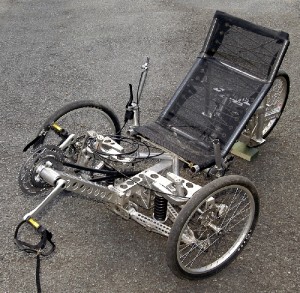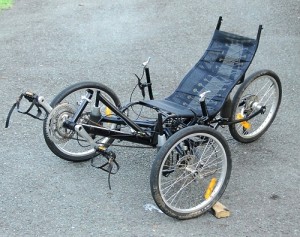I’m no natural designer…
I am not a natural designer; never have been and never will be.
The designs I produce are therefore the work of many hours of tortuous thought: of sketching and thinking; of looking up reference books and thinking some more.
Even a simple bracket can take me a long time; a more complex system can take me so many hours that, to be honest, you’d be frankly disbelieving if I told you the total.
How I envy those who combine natural artistry with engineering skills; those who have the ability to create beautifully elegant structures and shapes that also perform with engineering integrity. I think of those attributes – and the people who spring to mind are designers of bridges, of buildings and of dams: civil engineers and architects, rather than mechanical engineers.
Isambard Brunel and Thomas Bouch, certainly.
In the automotive field, it is hard to think off-hand of revered designers who could combine artistry with engineering elegance.
Colin Chapman?
Perhaps.
Ferdinand Porsche?
More so, I think – but ‘Porsche’ normally also includes son Ferry… so perhaps you’re getting two for the price of one.
Gordon Murray?
Yes, probably so.
Alex Issigonis?
Engineering? Without a doubt! Aesthetics? He had no bloody idea.
Anyway, as I was saying, automotive designers tend not to be able to combine innovative ideas with artistry.
Me? I can’t do innovation or aesthetics!
But I can try.
One of the outlets for my attempts has become, over the last few years, human-powered vehicles. Pedal bikes and trikes, if you like.
(A few years ago I had steel coil springs custom-wound for the suspension of a recumbent pedal trike I’d designed.
When I contacted the spring company – and in following discussion – I called the vehicle a ‘human-powered vehicle’.
When I picked up the springs, the salesman loudly proclaimed: “So these are for the bike, are they?”, by emphasis and with a touch of derision, clearly making his thoughts felt.
I replied: “Well, it’s got three wheels, so that makes it a trike doesn’t it?”
With visions of a child’s tricycle filling his mind, he was speechless.)
One of the beauties of building an HPV is that you can try pretty well anything you want – both legally and physically.
In my first really successful HPV, I used a front suspension design comprising semi-leading arms, with an anti-roll bar and a high geometric roll centre. Damping was by track change and Firestone rolling lip airbag springs were the springing medium.
(And if you think: “Yeah, whatever – WTF… that’s how I was too a few years ago. Boy, does building our own vehicle make you think hard about fundamental concepts of vehicular design!)
With its massively high roll centre and changing track, varying castor and camber, this suspension design went against almost everything I have ever read about suspension (for any vehicles!) – but on-road, it proved to be very good indeed.
And to be quite honest, that makes me feel warm inside: I did something that, AFAIK, no-one else has done on a vehicle – and it worked!
(Of course, someone, somewhere must have done it – but it’s certainly not a recognised front suspension design.)
Today, I got to the stage in my latest HPV build that I could statically assess the new front suspension – in terms of travel and roll stiffness, at least. (As I write this, the machine is at least another week away from road testing.)
And, at this early point in the design, it looks really good.
How so?
Well, it resists dive more than a single wheel bump. In fact, it has a much lower spring rate for a single wheel bump than a two-wheel bump. And, since most bumps are one-wheel, that’s good.
It incorporates the function of anti-roll bar into a suspension member. That saves potentially a lot of weight – not just for the anti-roll bar, but also for the links and rod-ends and anti-roll bar bearings.
And the suspension design has only four ball bearings (at a total of two pivot points).
…and it weighs – including suspension arms, pivot point bearings and two springs – just 1.4kg.
To carry a max dynamic load of about 150kg.
Its design? It’s a leading arm, torsion tube, dead axle, with a Watts link.
Weird? Very!
Unheard of? Again, I am not aware of any vehicle of any description using this approach on the front, steering, suspension.
Effective? I’ll find out when plunging down my local 20 per cent grades at 60 or 70 or 80 km/h, clad only in shorts, shoes, a t-shirt and bike helmet…

 Julian Edgar, 50, has been writing about car modification and automotive technology for nearly 25 years. He has owned cars with two, three, four, five, six and eight cylinders; single turbo, twin turbo, supercharged, diesel and hybrid electric drivelines. He lists his transport interests as turbocharging, aerodynamics, suspension design and human-powered vehicles.
Julian Edgar, 50, has been writing about car modification and automotive technology for nearly 25 years. He has owned cars with two, three, four, five, six and eight cylinders; single turbo, twin turbo, supercharged, diesel and hybrid electric drivelines. He lists his transport interests as turbocharging, aerodynamics, suspension design and human-powered vehicles.



on April 20th, 2009 at 9:29 am
I have to take some exception to you introduction, as a mechanical engineer who works with what you would call ‘natural engineers’ on a regular basis. Most of the architects have little or poor mechanical & civil engineering skills, and their designs are actually very poorly designed to their function. Behind every brilliantly designed structure is a team of engineers battling to make it work, and in most cases it wouldn’t without them. What you are doing, designing your bracket is the real nuts and bolts of design. Try being given a vague, often contradictory set of drawings of your HPV by a designer then spend months if not years building it to look like it, overcoming fundamental technical difficulties. Then after all that watch as the designer take all the credit. If you want to achieve a good aesthetic look, sketch the final product before you start and don’t compromise. Then you will be a ‘natural designer’, you’ll also have a HPV that will cost and weigh a lot more but it will look good.
on April 21st, 2009 at 11:35 pm
Well, you say the front suspension is unique for a front suspension, it’s not too dissimiliar to the rear suspension of a Peugeot 504 Estate which had a live axle. Unfortunately I can’t find an image on the net.
But hey, If you’re talking about combining artistry and engineering innovation together in a single package, the 504 will keep you on the right track 😛
on April 21st, 2009 at 11:40 pm
Mike I think you’re on the right track, it just takes them (‘designers’) a long time to realise we’re right and they’ve got it very wrong indeed.
on April 24th, 2009 at 3:58 pm
Well Julian, take heart, I would absolutely believe all the untold hours that go into designing something (anything!) Many years ago…down on the farm…! my mates and I would get together to build ‘buggies’ as we called them. They basically consisted of a motor bike engine, a couple of axles, a seat and some sort of steering. As we were always severely limited with our finances, we had to find some very creative ways of overcoming design problems. You should seen some some of the weird and wonderful stuff we built, not to mention the untold hours that went into working out how to do something! We had an absolute blast though, and for myself I learnt so much and thoroughly enjoyed designing and building our contraptions as much, if not more than, actually driving them. We’d often reach a point where we were stumped by a problem, then we’d realise that someone somewhere in the world had already faced a similar problem and overcome it. That would always give us heart to carry on. Anyone for Scrapheap Challenge?
on April 26th, 2009 at 3:31 pm
Julian – the Brunels of this world are rare, thats why they get into the history books. Give yourself credit for what you have done, and are doing. Logic will tell you that you DO have the creative spark, otherwise you wouldn’t be building/experimenting as you do…and writing it up so the rest of us can steal the ideas!
on April 27th, 2009 at 10:09 pm
SIr, u have inspired me a lot!
I surely agree with what u have done with your trike.
We cant tell the future, nor we are engineer enough to predict a design.
yet if we didnt try we wouldnt know.
Recently based on your article “negative boost” i made a radiator fan shroud to force expelled air from the radiator into the air filter box. it significantly reduces the vacuum in the manifold.
i know its hot air, but better than no air right? i’m still working on it
Thanks for the inspiration!
Regards
Kris
on May 6th, 2009 at 10:36 am
I think one point which has been lost in the world of modern ‘design’, is that the item should be true to the materials it’s constructed of. For example, in the past, brick buildings looked the way they did because they fit within the limits of brickwork. The wooden wheel of a horse and cart looked that way due to the limits of their wooden construction. As would have old steel bridges, etc.
Now marketeers are so concerned about the ‘look’, together with the innovations of modern materials and mass production, it’s possible to make things look like whatever whim comes to mind. Which, I think , usually results in rubbish.
Ben